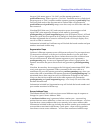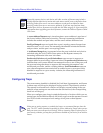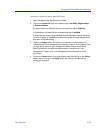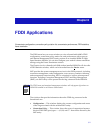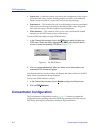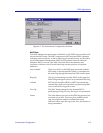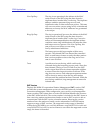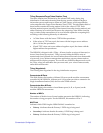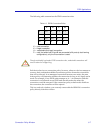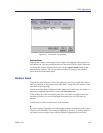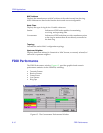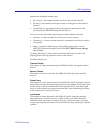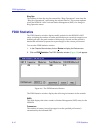
Concentrator Configuration 6-5
FDDI Applications
T-Req. (Requested Target Token Rotation Time)
The token rotation time bid made by the selected SMT entity during ring
initialization. Each station detecting that the ring must be initialized begins a
claim token process and issues a stream of Claim Frames, which negotiate the
value assigned to the Target Token Rotation Time (TTRT). The information Þeld of
these frames contains the issuing stationÕs bid for the value of TTRT. Each
claiming station inspects incoming Claim frames (from other issuing stations) and
either continues its own bid (and removes the competing Claim Frame from the
ring) or defers (halts transmission of its own bid and repeats the competing bid)
according to the following hierarchy of arbitration:
¥ A Claim Frame with the lowest TTRT bid has precedence.
¥ If the values of TTRT are equal, the frame with the longest source address
(48 vs. 16 bits) has precedence.
¥ If both TTRT value and source address length are equal, the frame with the
highest address has precedence.
The HSIM-F6 is shipped with a T-Req = 83 msec (earlier versions of Þrmware) or
6 msec (later Þrmware versions). T-Req is stored within the MIB in units of
nanoseconds (one billionth of a second) rather than milliseconds (one thousandth
of a second); your Cabletron management application converts nanoseconds to
milliseconds for display purposes. You can use any SNMP Set Request tool to edit
the T-Req value; just remember that you must enter your value in nanoseconds,
rather than milliseconds.
T-Neg. (Negotiated)
The winning time negotiated in the ring initialization sequence.
Concentrator M Ports
This Þeld displays the number of Master (M) ports on the modular concentrator
controlled by the HSIM-F6. A Master port is a port that provides a connection for
Single Attachment Station (SAS) devices to the FDDI network.
Concentrator Non-M Ports
This Þeld displays the number of non-Master ports (A, B, or S ports) on the
modular HSIM-F6 concentrator.
Number of MACs
The number of Media Access Control entities present in the HSIM-F6, indicating
the number of ring port pairs. For the HSIM-F6, this number will be 1.
MAC Path
Indicates which FDDI ring the HSIM-F6 MAC is attached to:
¥ Primary 1 indicates that the Primary 1 FDDI ring is being used.
¥ Secondary 1 indicates that the Secondary 1 FDDI ring is being used.
¥ Primary 2 indicates that the Primary 2 FDDI ring is being used.



